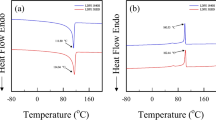Abstract
Elastomer injection moulding is a process whereby an elastomer mix is injected into a closed mould where the material is shaped to the desired geometry. Once completely filled, the silicone elastomer mix is vulcanised. Vulcanisation is the process whereby a viscous flow of silicone is converted into an elastic material through the incorporation of chemical cross-links between the material chains. To correctly use simulation tools to predict the filling of die mould cavities, it is necessary to characterise the material in terms of their rheological properties and kinetic behaviour during curing. The aim of this study was to develop mathematical models for the thermo-kinetic parameters of elastomers that can properly predict the filling of the die mould cavity. In this work, a rotational rheometer was used to determine changing viscosity and vulcanisation characteristics of a silicone compound. The rheokinetic properties of different silicone fluid samples were measured over a broad temperature range from 25 to 100 °C and are reported in this paper. Good agreement was obtained between the experimental results and the model predictions. The methods proposed could well represent the overall experimental data for different silicone elastomers; thus, it could be readily employed for simulation of the elastomer injection moulding process.
Similar content being viewed by others
References
Jerschow P (2001) Silicone elastomers, Wacker-Chemie GmbH, Rapra review reports. Report 137 12:5
Tang Y, Tan WK, Fuh JYH, Loh HT, Wong YS, Thian SCH, Lu L (2007) Micro-mould fabrication for a micro-gear via vacuum casting. J Mater Process Technol 192-193:334–339
Chung S, Park S, Lee I, Jeong H, Cho D (2004) A study on microreplication of real 3D-shape structures using elastomeric mold: from pure epoxy to composite based on epoxy. Journal of Machine Tools & Manufacture 44:147–154
Sahli M, Gelin J-C, Barriere T (2015) Replication of microchannel structures in WC–Co feedstock using elastomeric replica moulds by hot embossing process. Mater Sci Eng C 55:252–266
Ye X, Liu H, Ding Y, Li H, Lu B (2009) Research on the cast molding process for high quality PDMS molds. Microelectron Eng 86:310–313
Galeotti F, Chiusa I, Morello L, Gianì S, Breviario D, Hatz S, Damin F, Chiari M, Bolognesi A (2009) Breath figures-mediated microprinting allows for versatile applications in molecular biology. Eur Polym J 45:3027–3034
Bernardi L, Hopf R, Ferrari A, Ehret AE, Mazza E (2017) On the large strain deformation behavior of silicone-based elastomers for biomedical applications. Polym Test 58:189–198
Bernardi L, Hopf R, Sibilio D, Ferrari A, Ehret AE, Mazza E (2017) On the cyclic deformation behavior, fracture properties and cytotoxicity of silicone-based elastomers for biomedical applications. Polym Test 60:117–123
Arrillaga A, Zaldua AM, Atxurra RM, Farid AS (2007) Techniques used for determining cure kinetics of rubber compounds. Eur Polym J 43:4783–4799
Hong IK, Lee S (2013) Cure kinetics and modeling the reaction of silicone rubber. Journal of Indusrial and Engineering Chemistry 19:42–47
Polgar LM, Kingma A, Roelfs M, van Essen M, van Duin M, Picchioni F (2017) Kinetics of cross-linking and de-cross-linking of EPM rubber with thermoreversible Diels-Alder chemistry. Eur Polym J 90:150–161
Bideau PL, Ploteau JP, Dutournié P, Glouannec P (2009) Experimental and modelling study of superficial elastomer vulcanization by short wave infrared radiation. Int J Therm Sci 48:573–582
Khang TH, Ariff ZM (2012) Vulcanization kinetics study of natural rubber compounds having different formulation variables. J Therm Anal Calorim 109:1545–1533
Wang J, Fang X, Wu M, He X, Liu W, Shen X (2011) Synthesis, curing kinetics and thermal properties of bisphenol-AP-based benzoxazine. Eur Polym J 47:2158–2168
Erfanian M-R, Anbarsooz M, Moghiman M (2016) A three dimensional simulation of a rubber curing process considering variable order of reaction. Appl Math Model 40:8592–8604
Claxton WE, Liska JW (1964) Calculation of state of cure in rubber under variable time-temperature conditions. Rubber Age 95(2):237
Kamal MR, Sourour S (1973) Kinetics and thermal characterisation of thermoset cure. Polym Eng Sci 13(1):59
Isayev AI, Deng JS (1988) Non isothermal vulcanisation of rubber compounds. Rubber Chem Technol 61(2):340
In-Kwon H, Sangmook L (2013) Cure kinetics and modeling the reaction of silicone rubber. J Ind Eng Chem 19:42–47
Isayev AI, Deng JS (1987) Non isothermal vulcanisation of rubber compounds. ACS Rubber Division Meeting, Montreal
Sykutera D, Bielinski M (2010) The use of injection moulding process simulation software Cadmould for injection mould designing. J Pol CIMAC 5:207–213
White JL (1992) Rheological behaviour and boundary condition characteristics of rubber compounds. Journal of Applied Polymer Science: Applied Polymer Symposium 50:109–132
Bird RB, Armstrong RC, Hassager O (1987) Dynamic of polymeric liquids, volume 1: fluid mechanics, secon edn. Wiley, New York
Marzocca AJ, Mansilla MA (2006) Vulcanization kinetic of styrene-butadiene rubber by sulfur/TBBS. J Appl Polym Sci 101:35–41
Leroy E, Souid A, Sarda A, Deterre R (2013) A knowledge based approach for elastomer cure kinetic parameters estimation. Polym Test 32:9–14
Harkous A, Colomines G, Leroy E, Mousseau P, Deterre R (2016) The kinetic behavior of liquid silicone rubber: a comparison between thermal and rheological approaches based on gel point determination. React Funct Polym 101:20–27
Khang TH, Ariff ZM (2014) Mold filling simulation dependence on material data input for injection molding process of natural rubber compound, Carl Hanser Verlag GmbH & Co. KG, International Polymer Processing. J Polym Process Soc 325, 331
Author information
Authors and Affiliations
Corresponding author
Ethics declarations
Conflict of interest
The authors declare that they have no conflict of interest.
Additional information
Highlights
- The rheological and kinetic properties of different materials were compared.
- The rheokinetic models for elastomer silicones were investigated.
- An inverse modelling approach for the rheokinetic identification of elastomeric silicones was used.
- The experimental results compare favourably with theoretical predictions without causing a significant difference.
- Simulation of elastomer injection moulding process has been investigated.
Rights and permissions
About this article
Cite this article
Ou, H., Sahli, M., Barriere, T. et al. Experimental characterisation and modelling of rheokinetic properties of different silicone elastomers. Int J Adv Manuf Technol 92, 4199–4211 (2017). https://doi.org/10.1007/s00170-017-0481-0
Received:
Accepted:
Published:
Issue Date:
DOI: https://doi.org/10.1007/s00170-017-0481-0




